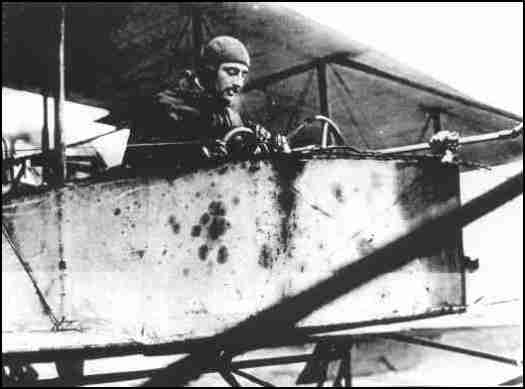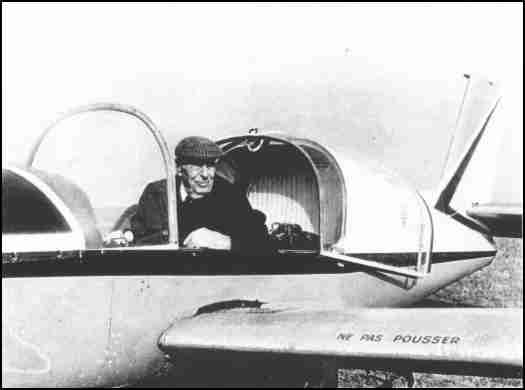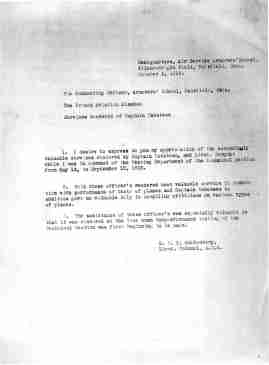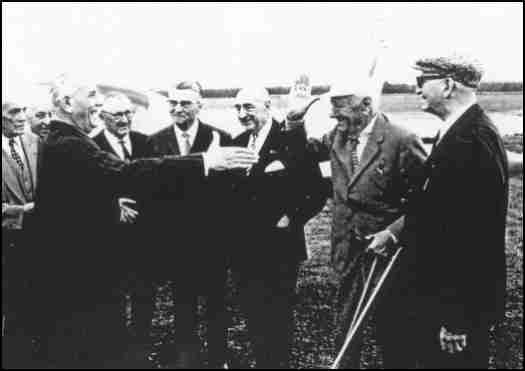
1884-1976 |
 |
Collection of Denys Tabuteau |
 |
Collection of Denys Tabuteau |
 |
 |
with fellow U.S. officer, 1917-1918 Collection of Denys Tabuteau |
Collection of Denys Tabuteau |
|
Headquarters, Air Service Armorers' School. Wilbur-Wright Field, Fairfield, Ohio. October 2, 1918 |
|
The Commanding Officer, Armorers' School, Fairfield, Ohio. The French Aviation Mission Services rendered of Captain Tabuteau |
|
1. I desire to express to you my appreciation of the exceedingly valuable services rendered by Captain Tabuteau, and Lieut. Sergent while I was in command of the Testing Department of the Technical Section from May 12, to September 13, 1918. 2. Both these officers rendered most valuable service in connec- tion with performance of tests of planes and Captain Tabuteau in addition gave us valuable help in compiling criticisms on various types of planes. 3. The assistance of these officers was especially valuable in that it was renndered at the time when the performance testing of the Technical Section was first beginning to be made. |
|
H. C. K. Muhlenberg, Lieut. Colonel, A.S.A. |
|
Sydney Morning Herald, 1961 By Peter Lucas When sprightly grandfather Max Conrad landed at Sydney, Australia recently, he underlined the fact that advancing years do not stop determined pilots from continuing to fly. CONRAD, 48, had just completed a lone 8,500-mile trans-pacific ferrying flight in a twin-engined Piper Aztec. Earlier this year he flew an Aztec nearly 30,000 miles around the world in eight days, 18 hours and 36 minutes, clipping 20 days off the record. Elsewhere, men in their fifties, sixties, and even seventies still remain at the controls in active flying roles. Test Pilot Most aviation companies in the Western World ground their commercial pilots at 45 or 50. But in Russia, a white-haired grandfather, Vladimir Kikkinski, remains on the top rung as a test pilot. Kokkinski, now 61, is said to be the oldest working test pilot in the world. He has the extraordinary record behind him of having nursed almost every aircraft designed in Russia since the revolution through the test stage. Among his latest jobs was to carry out preliminary flying checks on the most recent version of the Ilyushin-18 turbo-propeller transport. His test flying career began in the early 1920s when he checked the first crude Soviet-built machines. Kokkinski first attracted world attention in 1938 when he flew from Moscow to Vladivostok in 24 hours. The following year he took part in a record-breaking non-stop flight from Russia to the U.S.A. in under 24 hours. He continued flying throughout World War II and has twice been made a Hero of theSoviet Union. In Australia many men over the 50 mark also still fly commercially. N.S.W. has more than 20 active pilots in their late 50s. And there is one, the Columbus of world aviation flights of discovery, who is more than 60. The latter veteran is Captain Sir Gordon Taylor, G.C., M.C.. Pacific trailblazer, first with his crews from Sydney to Africa, across the Indian Ocean and from Sydney to South America, via Tahiti and Easter Island. Captain Harry Moss, who operates the Flying Doctor Service from Alice Springs, is 55 this year, but he still flies all over the Northern Territory and doubles as ground engineer. Captain Moss recently flew to Sydney to take over a new de Havilland Flying Doctor Drover plane. For Fun But all these fliers were still children when another veteran, Maurice Tabuteau, got his wings. Tabuteau, a Frenchman, was claimed last year as the world's oldest aviator of any description. Aged 77, he was then participating in an air rally of aviation veterans. He got his flying license in 1910, four years before the start of World War I, and set a distance record of 365 miles on the Tousus closed circuit 50 years ago. He was also the first man to fly six hours non-stop. A few months ago he was still flying a single-engined light plane, "just for fun." When they no longer want exacting responsibilitiees, commercial fliers can borrow a decade or more in the air by going "private." As airliners get bigger, men of experience are required on their flight decks like ocean liners need "old salts" with four rows of gold lace. |
 |
the first aviator ever to be involved in an air fight in 1914. Collection of Denys Tabuteau |
October 5, 1914, Sergeant Joseph Frantz (born in 1890, died in Paris in 1979) and his mechanic Louis Quénault, attached to the V 24 flotilla, flying a Voisin Type 3 biplane, shot down an Aviatik German, using a Hotchkiss machine-gun. The German aeroplane was piloted by sergeant Wilhelm Schlichting. His observer was lieutenant Fritz von Zangen and they were on A mission of recognizance over the French positions, close to Jonchéry on Vesle. After having expended all of the ammunition for the machine gun, the French began to fire their rifle at the German observer who was shooting at them with his own rifle. One shot by Quenault hit the pilot, causing him to lose control. The plane, although unverified, was surely destroyed when it crashed on the ground. This event marked the first confirmed air victory of World War I. This article is reproduced bhrough the courtesy of |
|
From The Early Birds of Aviation ROSTER, 1996 |
|
Recommended Links for Further Reading: You may visit these sites by clicking on the titles. Maurice Tabuteau by Denys Tabuteau Joseph Frantz Et Louis Quenault (French) |


|